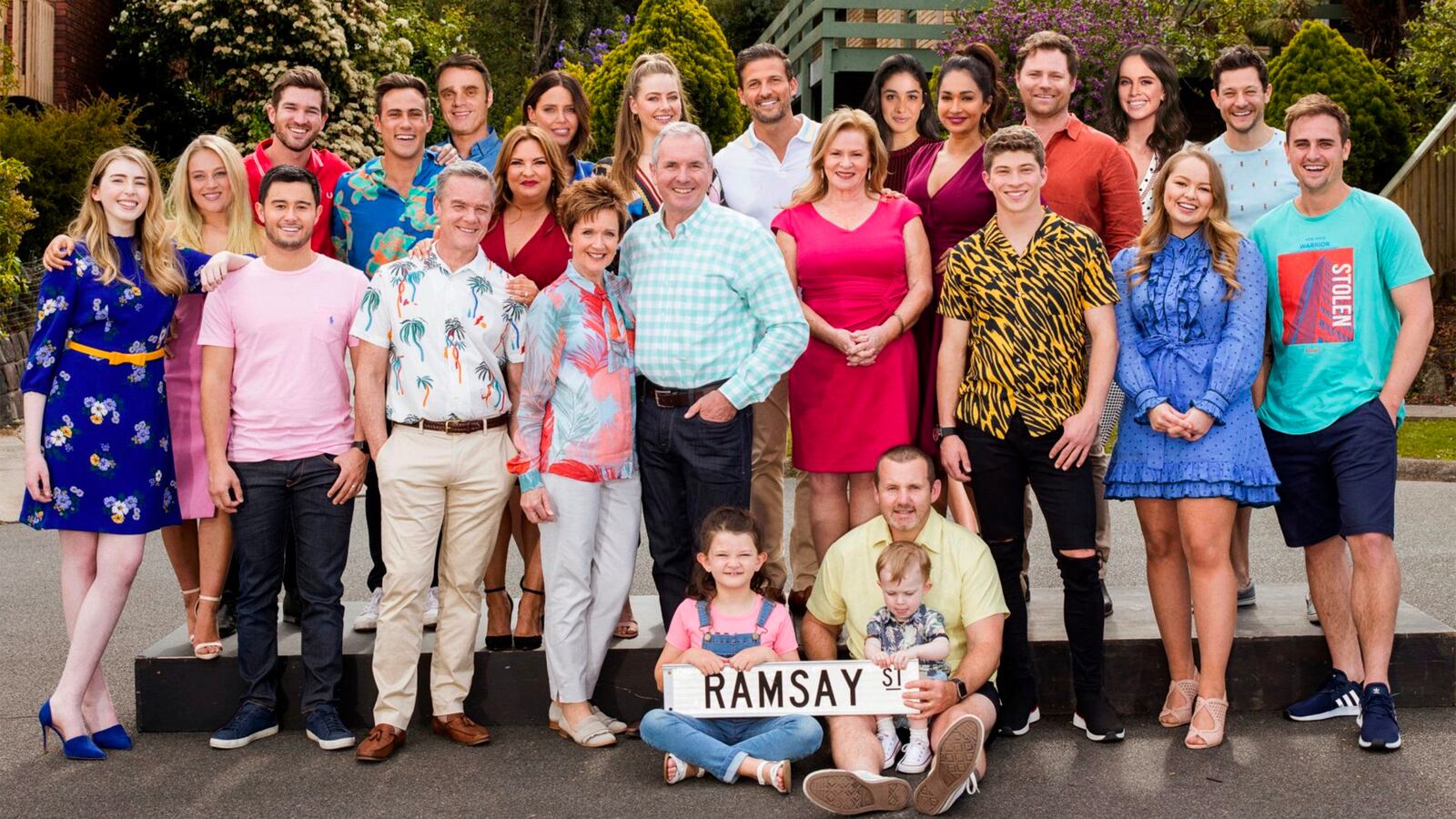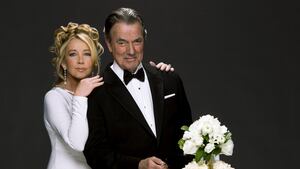There were Mrs. Mangel’s titanic battles with Madge, the nervous romance of Des and Daphne, poor Jim, eventually felled by a heart attack as his villainous, venal partner watched on. There was wise, sensible Helen, the time she was kidnapped and held in a garden shed, and her holiday in the Bungle Bungles. And, of course, there were Scott and Charlene, their epic romance, and marriage, as Angry Anderson sang the anthem “Suddenly” over the vows, their friends and loved ones dabbing their eyes, the cameras—as well as all of us watching—all misted up.

Mrs. Mangel.
FremantleIf this means nothing to you, fair enough. The Australian soap Neighbours, 36 years old and set on the mythical Ramsay Street in suburban Melbourne, is legendary in Britain—whose financial support has meant its continued existence these last few years. Now Channel 5, the independent station that housed the show after it left the BBC after 22 years, has announced it will no longer show it. Fans are not yet ready to mourn and are mobilizing to save the show via petition.
There is precedent for this. Neighbours was saved once from TV death near the start of its life, moving networks in Australia. Now the search is on by its makers Fremantle for a broadcast partner to ensure its continued life—and by the power of “Fiona Corke’s Wardrobe by Kamizole,” the show’s fans hope a rescuer is found. Jackie Woodburne, who plays Susan Kennedy, says the cast members are “very emotional.” Alan Fletcher, who plays her husband, Karl, says the show needs a “hero.”
As of the time of writing, Neighbours is 8,777 episodes old. Monday’s cliffhanger was a grief-stricken recent widower’s look of horror as he realized his baby had fallen off the couch on to the floor. The mysterious Freya went for a swim with hunky Levi, although her motives toward him seem suspect. Roxy and Kyle returned from their honeymoon, shamelessly horny. The show will end in August if no savior is found. We are promised an end that will do justice not just to its history but also the cloak of warmth of the show proudly wears.
What is its magic? Well, it is set in a cul-de-sac, where the sun always shines—unless there is rain or wind, usually a portent of disaster, as recently when a freak storm destroyed a bar and killed a character nobody cared about. Radically for a soap, early on it placed the dramas of the young characters on a par with their adults. Indeed, its teen stars, including Kylie Minogue (whom producers may approach to appear in the series finale if that becomes a reality), Guy Pearce, and Jason Donovan, all left Ramsay Street for fame elsewhere. Like its cousin Home and Away, Neighbours has provided a pipeline to Hollywood for its most talented and telegenic stars.

Kylie Minogue and Craig McLachlan in a 1987 episode.
Network Ten/Courtesy Everett CollectionIt has its share of psychopaths and villains like any soap opera—in recent years one insane teacher, who seemed reformed after a bout of amnesia before reverting to type, tried to kill everyone on an island. But the rigorously enforced tenet of the show is that everything and anything happens in this group of houses, and it is up to the enclosed community of people—who cannot stop befriending, backstabbing, shagging, and scheming against each other—to keep the community going.
Even its resident J.R. Ewing—Paul Robinson, a business empire owner whose portfolio jewel is the world’s strangest hotel complex, Lassiter’s—is rooted in the community, no matter how many neighbors he has plotted against and denigrated. The theme music has had many variations over the years, but its lyrics speak to the guiding principle of the show, “Everybody needs good neighbors/Just a friendly wave each morning/Helps to make a better day… Neighbors should be there for one another/That’s when good neighbors become good friends.”
Neighbours for many years was extremely white and extremely heterosexual. In recent times the show has tried, and succeeded and also flailed, to introduce diversity. It has faced demands to deal with alleged racism on set, as experienced by some of its lead actors, while on screen huge leaps forward in LGBTQ representation have taken place.
In Britain, it has always been shown twice a day—a fresh episode every lunchtime, repeated at teatime (the late afternoon). In its stratospherically popular early years, kids huddled around the TV sometimes twice a day for their daily fix. We remember the transformation of Plain Jane Superbrain, the unearthly humanoid characteristics of Bouncer the golden Labrador (who eventually, as we watched a little freaked out, dreamt he married another dog), and the time bumbling Harold fell off the rocks into the ocean, only to re-emerge five years later as a Salvation Army volunteer called Ted, who—yes, you guessed it—now had amnesia that could only be cured by the pure love of wife Madge.
The show has a devoted following and also—as has been evident since the axing news broke—a wider, extremely nostalgic one, remembering whatever period of the show they watched with great affection. The everyday of Neighbours reflected the everyday suburban life of so many—only with heightened drama.

The Neighbours cast in the 1980s.
FremantleIt also benefited from the influx of Australian daytime soaps that preceded it—Sons and Daughters, The Young Doctors, A Country Practice, and The Sullivans. The British appetite for these Aussie sudsers was insatiable even before the appearance of Neighbours and later at night Prisoner: Cell Block H. Despite the popularity of the primetime Dallas, Dynasty, Falcon Crest, and Knots Landing, American daytime soap operas never took off in the same way, despite a valiant attempt to seduce Brits with Santa Barbara.
Instead, Australia staked its claim to British daytime hearts. The success of Neighbours was squarely down to its rootedness, its good heart, and its perfectly timed daily intrusions into the TV schedule in a country known more for its rain than bright sunlight.
The way Neighbours was shown matched perfectly when people desired an escapist break from a day at work, or school, or parenting. It was scheduled before or after the news, and it took its audience to an attractive place full of attractive, but not alien-ly good looking, people. The drama may have sometimes been bonkers—and yes, there are doppelgängers in Neighbours, and characters returning from the dead—but this all takes place across dinner tables, or in a local café, or just on the street itself.
It’s only 25 minutes long, and no matter the adultery or poisoning and corporate chicanery on screen, every episode begins and ends with the cheery, tuneful resolution to behave well to each other.

Kylie Minogue, Craig McLachlan, Anne Charleston, and Ian Smith in the 1980s.
Network Ten/Courtesy Everett CollectionDoes its fundamental spirit of community goodness ever tire? No, episodes of Neighbours today are faster than an 1980s fan may remember, and far more sharply scripted. But that desire to come together and function as neighbors persists, unapologetically—and maybe, with so many people feeling disconnected in so many ways, it provides a vital shot of daily reassurance, or even an ideal to live up to. Ramsay Street may be full of trouble, but it is always trouble that can be resolved by talking, cooperating, and understanding.
The show doesn’t feel beaten up and scuffed. It has a good mix of old and new characters. So all it needs is a broadcaster to step in and take on Channel 5’s financial-custodial role. One hopes that savior will swoop in. But if this is the end—to match its demeanor—its devoted fans, and even ones who left it long behind years ago, will be left with the warmest memories.






